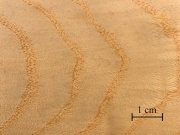Japanese ash
Jump to navigation
Jump to search
Description
A hardwood obtained from the tamo tree, Fraxinus mandshurica, or other similar trees (F. longicuspis, F. sieboldiana, F. chinensis), native to Japan, China, and northeast Asia. The tamo tree produces an elastic wood with a straight grain that polishes well. The white to pale yellow wood has a coarse texture. Japanese ash is used for furniture, cabinets, tools, sporting goods, Veneer, and Plywood.
Synonyms and Related Terms
Asiatic ash; Manchurian Ash (Fraxinus mandshurica); Japanese Ash (Fraxinus longicuspis); Japanese Flowering Ash (Fraxinus sieboldiana); Chinese Ash (Fraxinus chinensis); tamo ash; shioji; yachidama
Physical and Chemical Properties
- Specific gravity = 0.50
- Density = 31 ppcf
- Heartwood is light to medium brown; sapwood is lighter and very wide; deeply figured grain patterns are possible
- Grain is generally straight with a coarse uneven texture
- Resistance is poor for rot and insects
Working Properties
- Produces good results with hand or machine tools.
- Glues, stains, and finishes well.
Resources and Citations
- The Wood Database: Tamo ash
- R. J. Gettens, G.L. Stout, Painting Materials, A Short Encyclopaedia, Dover Publications, New York, 1966
- G.S.Brady, Materials Handbook, McGraw-Hill Book Co., New York, 1971 Comment: p. 74
- Gordon Hanlon, contributed information, 1998
- Kribs, Commercial Foreign woods on the American market Comment: p. 129
- Wikipedia: http://en.wikipedia.org/wiki/Ash_tree (Accessed Dec. 9, 2005)
- Van Nostrand's Scientific Encyclopedia, Douglas M. Considine (ed.), Van Nostrand Reinhold, New York, 1976
- Random House, Webster's Encyclopedic Unabridged Dictionary of the English Language, Grammercy Book, New York, 1997
